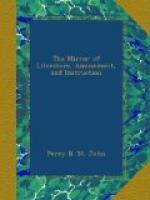But living art may not least part expresse,
Nor life-resembling pencil it can paint,
All it were Zeuxis or Praxiteles—
His daedale hand would faile and greatly faynt,
And her perfections with his error taynt;
Ne poet’s wit that passeth painter farre—
In picturing the parts of beauty daynt,” &c.
But neither Zeuxis nor Praxiteles was called from the dead to mar her perfections, nor record her negative charms. Poetry was the only art that flourished in the Virgin reign. The pure Gothic, after attaining its full efflorescence under Henry VII., departed, never to return. The Grecian orders were not only absurdly jumbled together, but yet more outrageously conglomerated with the Gothic and Arabesque. “To gild refined gold—to paint the lily,” was all the humour of it. A similar inconsistency infected literature. The classic and the romantic (to use those terms, which, though popular, are not logically exact) were interwoven. The Arcadia and the Fairy Queen are glorious offences, which “make defect perfection.” Perhaps, Shakspeare’s “small Latin and less Greek,” preserved him from worse anachronisms than any that he has committed. Queen Bess’s patronage was of the national breed: she loved no pictures so well as portraits of herself. As, however, her painters have not flattered her, it may not uncharitably be concluded that they were no great deacons in their craft. It is a much easier thing to assure a homely female, in prose or rhyme, that she is beautiful, than to represent her so upon canvass. Her effigies are, I believe, pretty numerous, varying in ugliness, but none that I have seen even handsome—prettiness, of course, is out of the question. She was fond of finery, but had no taste in dress. Her ruff is downright odious; and the liberal exposure of her neck and bosom anything but alluring. With all her pearls about her, she looks like a pawnbroker’s lady bedizened for an Easter ball, with all the unredeemed pledges from her husband’s shop. She seems to have patronized that chimera in the ideal or allegorical portrait, at which Reubens and Sir Joshua were so often doomed to toil. She would not allow a shadow in her picture, arguing, like a Chinese, or a chop-logic, that shade is only an accident, and no true property of body. Like Alexander, who forbade all sculptors but Lysippus to carve his image, she prohibited all but special cunning limners from drawing her effigy. This was in 1563, anno regni 5, while, though no chicken, she still was not clean past her youth. This order was probably intended to prevent caricatures. At last she quarrelled with her looking-glass as well as her painters, and her maids of honour removed all mirrors from her apartments, as carefully as Ministers exclude opposition papers (we hope not Maga) from the presence of our most gracious sovereign. It is even said, that those fair nettles of India took advantage of her weakness, to dress her head awry,




